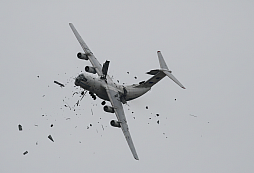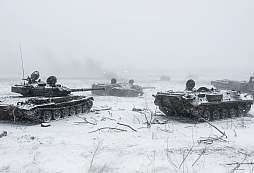Unmanned threat: Czech and Slovak solutions against drones
The news coming in every day from the Ukrainian battlefield clearly demonstrates the enormous and ever-growing importance of unmanned aerial vehicles, especially the smallest ones. Until relatively recently, they were considered more of an entertaining curiosity, but the great potential of these machines, both in the civilian and military sectors, soon became apparent. Small drones with cameras quickly ceased to be mere toys and became useful tools. Then there was only one step left to turn these machines into deadly weapons. About ten years ago, small drones began to serve as makeshift ammunition carriers, or "unmanned bombers." The conflict in Ukraine subsequently brought about another huge boom in these machines, and the general public became familiar with the acronym FPV (First Person View), which is commonly used to refer to small and very fast drones that are controlled by an operator wearing goggles, i.e., literally "from the drone's perspective." In Ukraine, these devices are mainly used for "suicide" attacks and function as a supplement or partial replacement for artillery.

However, drones are also used in a number of other roles in Ukraine, as they function as supply vehicles, lay and destroy mines, and provide communication with other drones as retransmitters. Of course, the two main purposes remain reconnaissance and attacks, both “suicide” attacks and those using carried and dropped ammunition. Both sides are naturally exploring and deploying a variety of methods to counter drones. The spectrum of methods is extremely wide, and therefore firearms ranging from shotguns to machine guns, various directional and non-directional jammers, net throwers, and now also “fighter” drones, which are used to destroy the enemy's unmanned vehicles, are used on the battlefield. All of this is being closely monitored by armies around the world, which are trying to learn lessons and introduce both drones and effective means of protection against them into their arsenals. The defense industry of the Czech Republic and Slovakia cannot remain on the sidelines, as demonstrated by a number of exhibits at the IDET 2025 trade fair, which took place at Brno in May.
One of the most significant and eagerly awaited premieres was undoubtedly the Pandur 8x8 EVO eight-wheeled combat vehicle, developed by Tatra Defence, part of the Czechoslovak Group. This armored vehicle builds on the Pandur II 8x8 CZ platform, but at the same time brings significant improvements in all areas, including ballistic and mine protection, as well as in terms of combating small drones. Its standard armament is the Israeli UT30 MK2 unmanned turret from Elbit Systems, but its licensed serial production is expected to take place in the Czech Republic. The turret is equipped with a 30mm Bushmaster Mk 44S automatic cannon, which is also capable of firing fragmentation ammunition with a time fuse, offering high effectiveness against small unmanned aerial vehicles. The Pandur 8x8 EVO can also be equipped with other anti-drone systems, such as electronic jammers.

In addition to its basic form, i.e., a wheeled combat vehicle for transporting and supporting infantry, the Pandur 8x8 EVO platform can, of course, be adapted for a wide range of other purposes. This was clearly demonstrated by another example of the Pandur II 8x8 series eight-wheeled armored vehicle, which was again equipped with a turret from the Israeli company Elbit Systems, but this time in the UT30 MK3 version. This is already optimized primarily for short-range air defense, which is usually referred to by the acronym SHORAD (Short Range Air Defense), to which defense against drones, or C-UAS (Counter Unmanned Aerial Systems), has recently been added. This turret also features the aforementioned 30mm cannon with the option of firing programmed ammunition, but the UT30 MK3 turret is characterized by a lighter construction. In addition to the cannon and machine gun, it can also carry launchers for guided missiles against air targets and is equipped with radar antennas that contribute to the early detection and accurate tracking of drones.
The Pandur 8x8 EVO armored vehicle is, of course, one of the favorites to replace the current Pandur II eight-wheeled combat vehicles in the Czech Army. However, two competing models also arrived at Brno, namely the Finnish Patria AMV XP and the German Boxer armored vehicle. Both were equipped with Turra 30 turrets from the Slovak company EVPÚ a.s. These turrets are used on several armored platforms of the Slovak Army and are continuously being modernized.

The original version still carries a copy of the old Soviet 30mm 2A42 cannon, while newer versions are already equipped with Bushmaster weapons. EVPÚ a.s. also exhibited a completely new variant called Turra 30 V10 at Brno, which already carries the HARPIA active protection system developed by its Czech sister company EVPÚ Defence, which should also be used against small unmanned aerial vehicles.

In addition, EVPÚ Defence brought a wide range of other weapon stations, including the new Gladius MAX, which carries a 30mm cannon and is primarily designed to combat drones.

The importance of remote-controlled weapon stations suitable for this role was also demonstrated by several other exhibits in this category. For example, Excalibur Army brought a new version of its successful Patriot 4x4 armored vehicle, which is mounted on a Tatra off-road chassis and has already won several export contracts. This year's version featured a Trakon 30 remote-controlled weapon station from the Turkish company Unirobotics on its roof. This station is equipped with a 30mm Venom LR automatic revolver cannon, which can also fire rounds with proximity fuses. The Mangart 25 AD turret, which represents a product of the Slovenian company Valhalla Turrets, also belongs to a similar category and is also found on the Wolf 25 AD armored vehicle from the Slovak brand DefTech, which is competing in the Slovak Army's tender for a new armored vehicle. The turret is equipped with a 25 mm Oerlikon KBA cannon and radar, which allows for accurate firing even against small unmanned aerial vehicles.

It is also interesting to note that the Slovak Wolf 25 AD armored vehicle has apparently already begun to gain real combat experience, as the manufacturer has delivered several units to Ukraine. This is undoubtedly an extremely effective way to evaluate the real effectiveness of the technology in combat conditions, which no tests at firing ranges can provide. The experience gained in Ukraine is naturally also reflected in the development of other types of weapon stations, including small ones equipped only with machine guns. One example exhibited at the IDET 2025 trade fair is the Hector system from Excalibur Army, which is based on the proven Toyota Land Cruiser 79 off-road vehicle.

Its stern is equipped with a Guardian 1.5 weapon station supplied by the Spanish company Escribano, which carries a 12.7 mm M2HB machine gun. Although the Hector system is primarily described as a patrol vehicle, its fire control system also allows it to engage effectively against airborne targets.

Returning to larger-caliber automatic weapons, it should be emphasized that self-propelled anti-aircraft complexes with automatic cannons are also proving extremely effective in Ukraine, primarily the German Gepard type with a pair of 35 mm cannons. This weapon is conceptually followed by the remote-controlled Skyranger turret system, manufactured by the German company Rheinmetall, which may already be in Ukraine. According to unofficial information, the Czech army is also interested in it. The primary weapon of the Skyranger complex is a 30mm or 35mm automatic cannon, which can fire programmed ammunition, and in addition, the turret also houses a tilting launcher for four light anti-aircraft guided missiles. The Skyranger is most often presented on a Boxer chassis, but other platforms can of course also be used, which is why, in addition to the Pandur 8x8 chassis, the possibility of using a Tatra chassis is also being discussed in Czechia.

Another application for the Kopřivnice automotive chassis in the drone defense sector is offered by cooperation with the Turkish company Aselsan. Over the past decade, Aselsan has developed the Korkut self-propelled anti-aircraft system, which includes a pair of 35 mm Oerlikon automatic cannons, giving this system truly impressive firepower. Korkut is, of course, also capable of firing ammunition with a programmed fuse, which is manufactured in Turkey under the name ATOM. The standard version of the Korkut system, which has been adopted by the Turkish army, uses an ACV-30 tracked chassis, but the turret can also be mounted on other platforms. This was demonstrated by a model at the IDET 2025 trade fair, which showed the complex mounted on a six-wheeled Tatra Force chassis with an armored cabin. Such a combination offers excellent capabilities and can be expected to have considerable export potential.
Experience from Ukraine also shows that one of the most effective means of protection against drones is other drones, i.e., "unmanned fighter drones." These are generally machines that destroy enemy drones either by direct contact or with the help of onboard weapons, such as net throwers. The first approach was demonstrated by two unmanned vehicles exhibited by the Czech company TRL Drones. In both cases, these are very fast machines with fixed wings and a long range, which is 40 km for the smaller and over 200 km for the larger. The second approach described is illustrated by the Hunter "fighter" drone, which was on display at the Brno Exhibition Center as part of Excalibur International's exhibition of small unmanned aerial vehicles. This time, it is a small quadcopter that is launched by hand, carries a net launcher, and has a range of 5 km. Both companies emphasize the cost-effectiveness of their drones, which is becoming increasingly important today.
The price of specific weapons is a factor that is sometimes overlooked but certainly deserves attention. It is undoubtedly technically possible to hit and destroy a small drone with a large guided missile, but if this missile is many times more expensive than the drone itself, it inevitably raises the question of whether such a step makes sense. Once again, it is necessary to refer to the experience of Ukraine, which proves that there are tactically and technically effective and at the same time affordable solutions against small drones. In addition to "unmanned fighter drones," these include mainly firearms, in particular small-caliber automatic cannons or large-caliber machine guns, which of course need to be connected to suitable fire control systems. Effective protection against small unmanned aerial vehicles can then be provided by a wide range of suitably modified combat vehicles. The exhibits at the IDET 2025 trade fair clearly demonstrate that Czech and Slovak industry wants to be heavily involved in this lucrative sector and that it can offer interesting solutions.
























